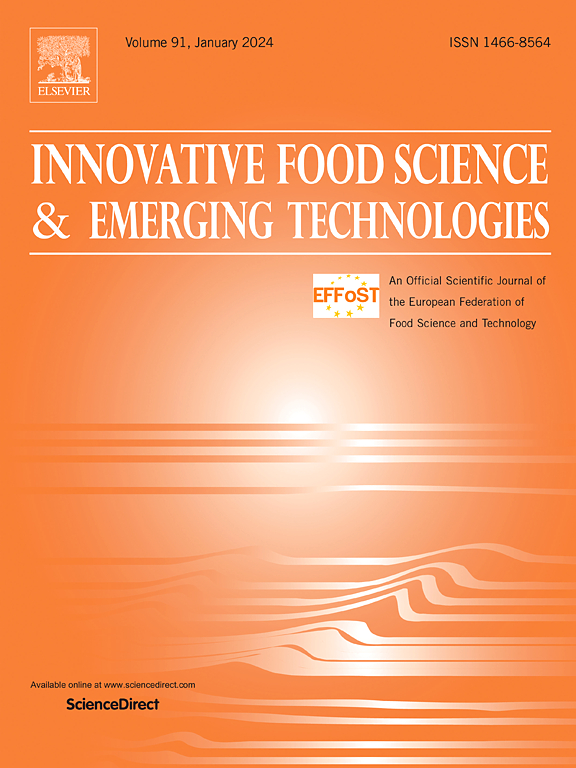Enhancing DHA algal oil delivery with emulsions: Impact of high-pressure homogenization and ultrasonication on in vitro digestion and ex vivo absorption efficiency
IF 6.3
1区 农林科学
Q1 FOOD SCIENCE & TECHNOLOGY
Innovative Food Science & Emerging Technologies
Pub Date : 2025-07-21
DOI:10.1016/j.ifset.2025.104124
引用次数: 0
Abstract
Docosahexaenoic acid (DHA), an essential omega-3 fatty acid with well-documented health benefits, faces challenges in food applications due to its poor water solubility, oxidative instability, and limited intestinal absorption. Lipid-based emulsions offer a promising strategy to enhance DHA delivery; however, the influence of high-pressure homogenization (HPH) and ultrasonication (US), which are widely employed high-energy preparation techniques, on DHA digestion and absorption remains inadequately understood. In this study, DHA algal oil emulsions stabilized with whey protein isolate (WPI) were prepared using HPH (at 120, 240, and 500 bar) and US (at 100, 200, and 300 W), and their in vitro digestion and ex vivo intestinal absorption efficiency were evaluated. The results indicated that all emulsions, with mean particle sizes ranging from 228 to 746 nm, exhibited similar microstructure during digestion, with oil droplets aggregating and increasing in size during gastric phase, followed by a reduction in size due to hydrolysis of proteins and oil droplets in the intestinal phase. At the end of digestion, the degree of proteolysis was higher in HPH-produced emulsions (29.0 % to 30.4 %) compared to US-processed emulsions (25.7 % to 27.1 %). Similarly, HPH-treated emulsions also demonstrated a greater free fatty acid (FFA) release (30.1 % at 120 bar to 32.0 % at 500 bar) than those prepared with US (23.6 % at 100 W to 28.7 % at 300 W), with both techniques yielding higher FFA release ratio than bulk oil (18.4 %). Ex vivo absorption studies using a rat small intestine model revealed that emulsions significantly improved FFA absorption (22.5 % to 29.1 %) compared to bulk oil (8.3 %), although no statistically significant difference was observed between HPH- and US-treated emulsions. This study provides valuable insights into how preparation techniques influence DHA digestion and absorption efficiency, thus offering strategies to optimize DHA emulsion-based delivery systems for enhanced bioavailability.
乳状液增强DHA藻油的输送:高压均质和超声对体外消化和体外吸收效率的影响
二十二碳六烯酸(DHA)是一种必需的omega-3脂肪酸,具有良好的健康益处,但由于其水溶性差、氧化不稳定性和肠道吸收有限,在食品应用中面临挑战。脂基乳剂提供了一种很有前途的策略来增强DHA的输送;然而,高压均质(HPH)和超声(US)这两种广泛应用的高能制备技术对DHA消化吸收的影响尚不清楚。本研究以分离乳清蛋白(whey protein isolate, WPI)为稳定剂,分别在120、240和500 bar的HPH和100、200和300 W的US条件下制备了DHA藻油乳状液,并对其体外消化和体外肠道吸收效率进行了评价。结果表明,乳状液的平均粒径在228 ~ 746 nm之间,在消化过程中表现出相似的微观结构,在胃期油滴聚集并增大,随后在肠期由于蛋白质和油滴的水解而减小。在消化结束时,hph产生的乳剂的蛋白质水解程度(29.0%至30.4%)高于美国加工的乳剂(25.7%至27.1%)。同样,hph处理的乳剂也显示出更高的游离脂肪酸(FFA)释放率(在120巴时为30.1%,在500巴时为32.0%),而用US制备的乳剂(在100瓦时为23.6%,在300瓦时为28.7%),两种技术的FFA释放率都高于普通油(18.4%)。利用大鼠小肠模型进行的体外吸收研究显示,与大油(8.3%)相比,乳剂显著提高了FFA的吸收(22.5%至29.1%),尽管HPH处理的乳剂和us处理的乳剂之间没有统计学上的显著差异。该研究为制备技术如何影响DHA消化和吸收效率提供了有价值的见解,从而为优化DHA乳基传递系统以提高生物利用度提供了策略。
本文章由计算机程序翻译,如有差异,请以英文原文为准。
求助全文
约1分钟内获得全文
求助全文
来源期刊
CiteScore
12.00
自引率
6.10%
发文量
259
审稿时长
25 days
期刊介绍:
Innovative Food Science and Emerging Technologies (IFSET) aims to provide the highest quality original contributions and few, mainly upon invitation, reviews on and highly innovative developments in food science and emerging food process technologies. The significance of the results either for the science community or for industrial R&D groups must be specified. Papers submitted must be of highest scientific quality and only those advancing current scientific knowledge and understanding or with technical relevance will be considered.

 求助内容:
求助内容: 应助结果提醒方式:
应助结果提醒方式:


